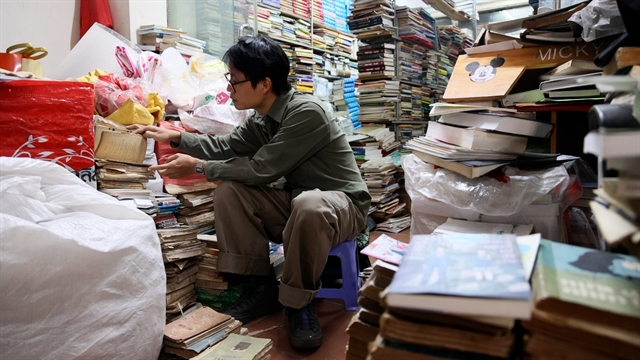 Life & Style
Life & Style

"They bloom in a short period, so if you guys do not hurry you will have to wait another year!"

|
Đà Lạt has Việt Nam's largest area of dã quỳ. The Mexican sunflowers are in bloom this time of year. Photo dulichdalat.pro
Thanh Hà
After waking up early, Bùi Thanh Tuyền and her friends were ready just minutes later to start their flower tour in a suburb of Hà Nội.
It took the friends about an hour and a half hour to reach Ba Vì District, 50km from the city centre. Here, they could admire the beautiful yellow dã quỳ (Mexican sunflower or tree marigold) fields that have become a magnet for thousands of people in the area.
"I just heard about dã quỳ in the north recently. I talked with my friends and we were all excited about the tour. We did not want to miss the season of dã quỳ, which only last a few weeks in the last three months of the year," Tuyền told Việt Nam News.
"They bloom in a short period, so if you guys do not hurry you will have to wait another year!"
Tuyền and her friends shared that they had a great time together, taking photos to remember their time with the dã quỳ. They all agree that they will come back to Bà Vì next year.

|
Bùi Thanh Tuyền (right) and her friends are among thousands of visitors touring Bà Vì District to take photos with the beautiful dã quỳ flowers. -- Photo of Bùi Thanh Tuyền
Hoàng Quang Khôi wanted to relax after a busy working week and decided to take his family to the Ba Vì National Park, 10km further from where Tuyền was, to see the flowers.
"We took a bus to get there. On the way to the park, we saw many pathways with dã quỳ blossoms but here it is like a huge garden. We are in front of a big large golden carpet of flowers," said Khôi.
"We have to get up early to get here at the best time of day, between 8-10 am in the morning, otherwise we would have to wait until 5 or 6pm when the flowers are golden in the sunset.
"If possible, I would like to camp here, spending the night in the park, and then we can see these beauties during sunrise, which would be amazing!" said Khôi, who joined hundreds of people in taking photos with the wild yellow blossoms.
Dã quỳ are visible from the gates of the park and can be seen along most of the 12.5km road to the top of Ba Vì Mountain.
In Việt Nam, the flowers are also called cúc quỳ, sơn quỳ, quỳ dại and hướng dương dại. They are a symbol of faithful love, energetic vitality, pride and resilience. When exactly they bloom changes a little bit each year, depending on the weather conditions, but it is usually between October and the end of December.
It is said that the French grew dã quỳ in the 1930s. For many years, it was considered a kind of wild plant and was regularly uprooted. But since 2015, the park managers decided to let them grow and began taking care of them. They realised that tourists love the flowers and they come back more often for them.
Dã quỳ is a member of the daisy family. It also can be found in various cool climate localities such as in Mộc Châu District, Sơn La Province, and Pass Sài Hồ in Lạng Sơn Province in the north, Quảng Trị Province's Hướng Hóa District in the central region and Gia Lai Province's Pass Mang Yang and Chư Đăng Ya Volcano in the Central Highlands. But Đà Lạt City in Lâm Đồng Province is the most famous destination for this flower.
Dã quỳ can be seen in various corners in the highland city but the best sites are on the outskirts. Trekkers and locals have mapped out different routes to these help tourists make the most of the beautiful scenery.
People can visit Vạn Thành Flower Village, Elephant Waterfall and Langbiang Mount which is about 13km from the centre city. Following another road, visitors can travel about 30km to Trại Mát and Cầu Đất areas in Xuân Trường District. Around 100km away are more spots in Tà Nung, Đơn Dương and Tu Tra.
This time of the year is also the season of many other beautiful flowers for tourists in Đà Lạt.

|
| No Title |
Pink foxtail grass has lured people, especially the young generation, in recent years. The grass turns pink in early November and remains that colour for more than a month. This wild grass covers the hills near Tuyền Lâm Lake, Golden Stream and Thái Phiên Flower Village.
“The Golden Stream is the most desired spot for wedding photos this season. Here, they will have a beautiful and romantic background that will make their albums spectacular," said Phạm Minh Tài, who took photos for Tiên Tiên, a bride from Đồng Nai.
Tiên said it was not difficult to get to Đà Lạt. People have to make a health declaration before arriving in the city and follow COVID-19 instructions.
She believed that her album with the pink foxtail will be the best memory of her life.
November and December are the months of the mimosa, or silver wattle, which is native to Australia but can also be found in Đà Lạt, where it is considered a symbol of the city as it can be found nowhere else in the country.
The small yellow or golden-yellow flowers are very fluffy in appearance, due to the presence of numerous stamens. The delicate, fern-like silvery green leaves are attractive all year round. The plants become a mass of bright yellow when they flower in late winter.
A huge number can be found at Pass Prenn and Pass Mimosa.
Back to the north, Sơn La Province's Mộc Châu plateau is a must-visit destination for its overwhelmingly beautiful white rapeseed and white plum flowers, which bloom from December to early February.
Vast white rapeseed fields in Áng and Pa Phách villages are the biggest and most beautiful, providing tourists with enchanting flowers that stretch to the horizon.
The plum flowers cover many hills and valleys. Visitors can see their blossoms everywhere, from villages to upland fields and along both sides of the highways.

|
| Plum tree flowers in Mộc Châu will be at their best during the next couple of weeks. Photo vietnamplus.vn |
Nà Ka valley, home to over 100ha of clear plum trees, has an exquisite landscape, fresh mountain air, and juicy plums that can be eaten right off the tree in the harvest season.
The next destination for flowers should be Hà Giang Province, about 280km from Hà Nội.
Tam giác mạch (buckwheat) blossoms have tiny wild pink flowers with triangular-shaped leaves, which are in season from late October to December.
The flowers typically have three colours; light pink, glistening purple and dark red. In the bright sunshine, they look like a watercolour painting. Their wild and endless beauty has seduced many people.
Buckwheat flowers symbolise love and happiness. They are cultivated for their grain-like seeds, which are used to make food specialities by ethnic people in the mountainous region.
Sủng Là, Lũng Cú and Xín Mần districts are familiar names to many that have attended the annual Tam Giác Mạch Festival.
"Hà Giang is my next destination, though I will have to check the COVID-19 pandemic control measure before travelling. I can't wait to visit see the buckwheat flowers," Tuyền said.
The mother of three also wants to take photos with cúc họa mi (white daisy) in Hà Nội, which has been a hot trend in the capital in recent weeks.
There are many breathtaking fields of flowers that are just waiting for flower lovers to visit, including 60ha of sunflowers in Nghĩa Đàn District in Nghệ An Province; a vast sea of Chi Pâu or swertia in the Tà Chì Nhù Mount in Yên Bái Province; and rapeseed flower fields in Thái Bình Province's Vũ Thư District and Hà Nội's Gia Lâm District. VNS

|
Tam giác mạch (buckwheat) blossoms in Hà Giang Province. Photo didauvui.com
.jpg)
|
| Mexican sunflowers in Đà Lạt. Photo of dulichdalat.pro |
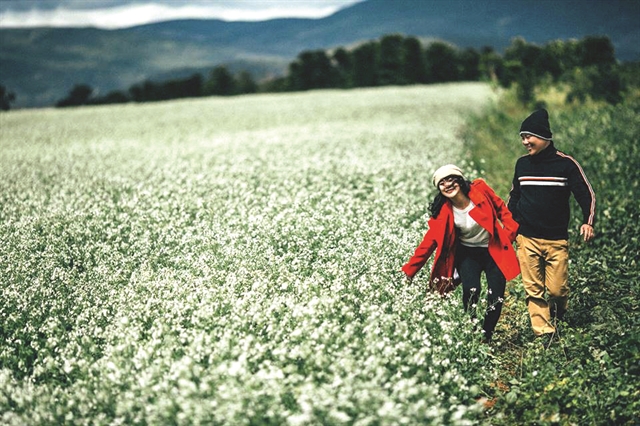
|
| White rapeseed flowers in Sơn La Province Province. Photo of Kim Ui |
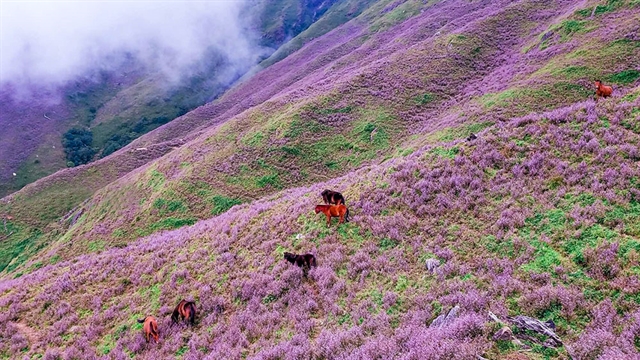
|
| Swertia can be found in Tà Chì Nhù in Yên Bái Province. Photo fantasea.vn |

|
| White daisies in Hà Nội. Photo laodong.vn |
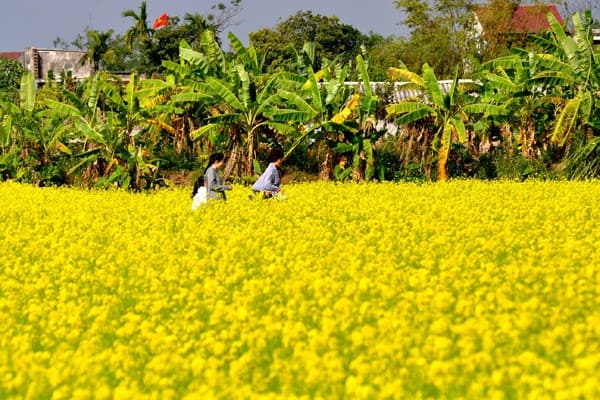
|
| Rapeseed flowers in Thái Bình Province. Photo pystravel.vn |
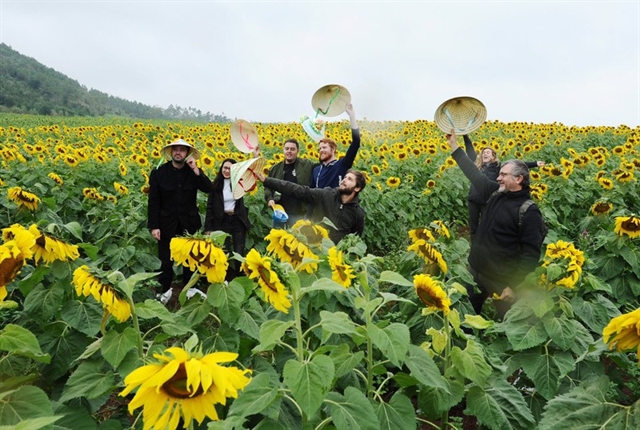
|
| A sunflower field in Nghệ An Province. Photo baophapluat.vn |